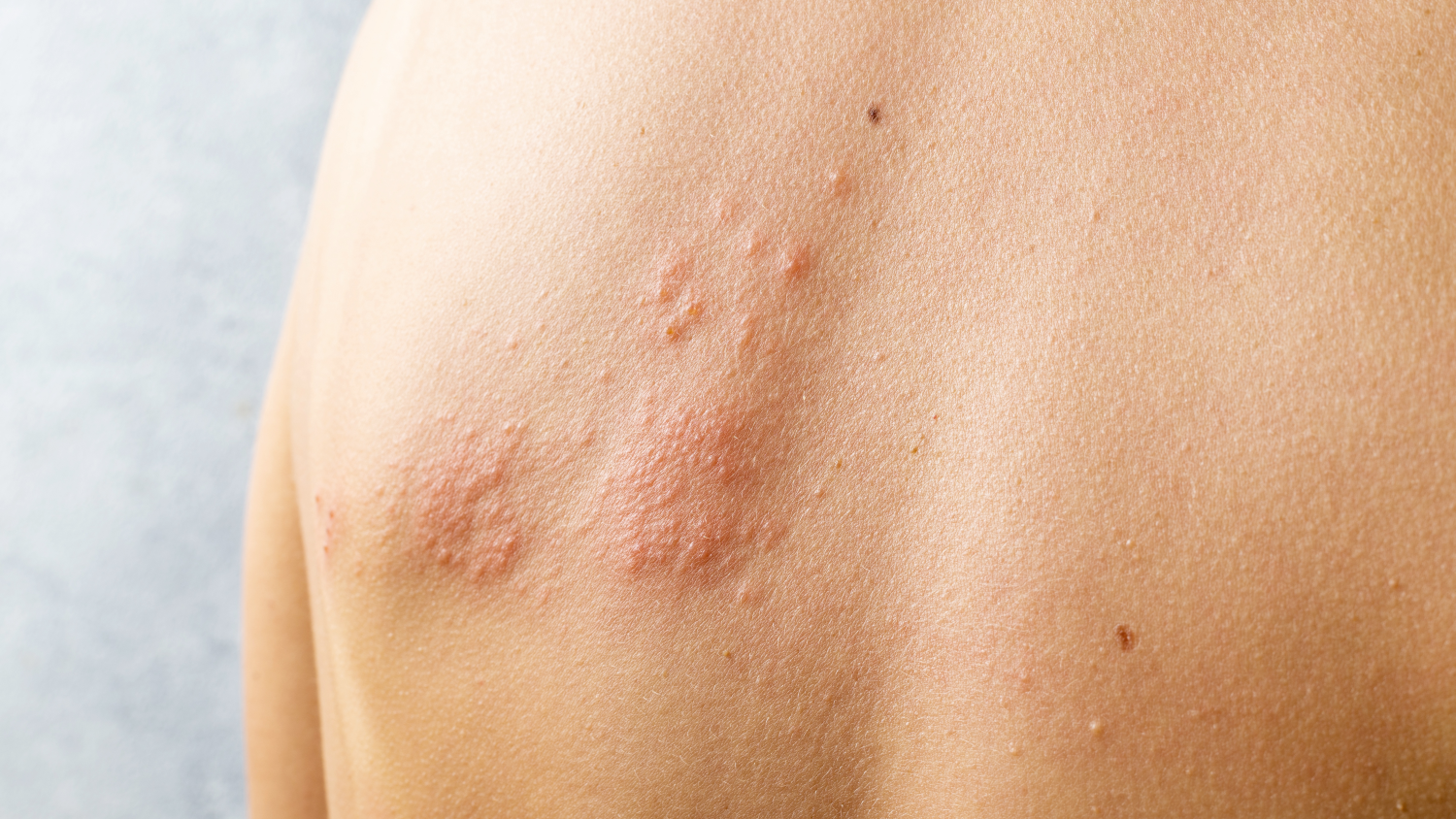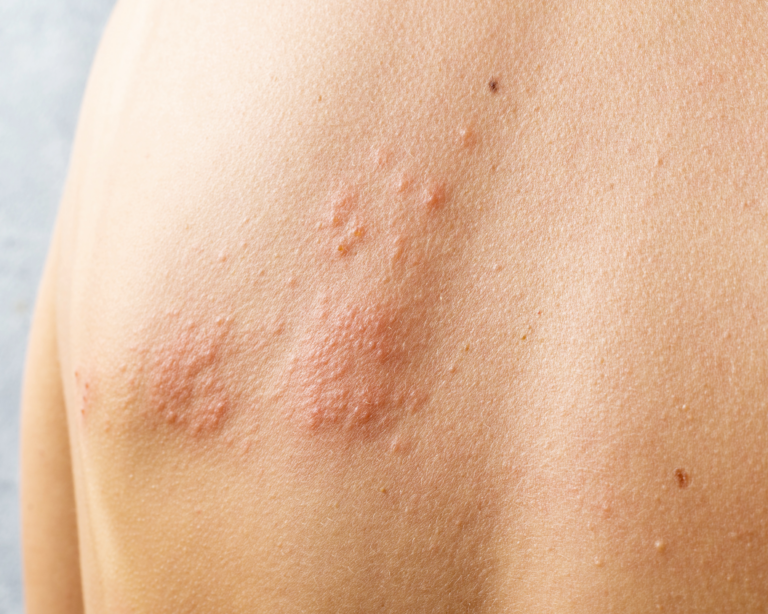When these viruses become active again, the painful shingles blisters develop. They can be combated with medications that relieve the pain or contain the viruses. Timely vaccination can prevent herpes zoster from breaking out in the first place.
Overview: What is shingles?
Shingles gets its name because of its typical appearance. It often produces skin rashes that run like a belt or cord over a nerve pathway that lies beneath the skin.
Anyone who comes down with shingles has become infected with viruses. They belong to the herpes virus family and are also the cause of chickenpox, which always precedes shingles. Only those who have had a chickenpox infection can get herpes zoster. More than 95 percent of all adults in Switzerland contracted chickenpox in childhood. Even if you no longer remember it and this childhood disease is long behind you: The viruses that caused it, the so-called varicella zoster viruses, are still dormant in your body.
These viruses do not cause a new outbreak of chickenpox, but they can cause unpleasant shingles (herpes zoster). One in three adults will experience this at some point, usually in later life. Affected are predominantly women and men aged 50 and older, as well as people suffering from immunodeficiency. In rare cases, however, younger people also contract herpes zoster. In total, around 20,000 to 40,000 people in Switzerland are diagnosed with shingles every year.
Origin: How does shingles (herpes zoster) develop?
Why viruses that have been inactive for years or even decades suddenly come to life and produce shingles is not precisely known. What is certain, however, is that this happens primarily when the body’s own immune defenses no longer function optimally. This can be the case in old age or in the case of an immune deficiency, such as occurs during or after a serious illness.
When the time comes, the varicella zoster viruses first begin to multiply. Subsequently, they move along nerves towards the skin, causing inflammation. In response, painful blisters filled with viruses form under the surface of the skin. They are arranged in groups and appear as a reddish rash. It is also called zoster.
Unlike the highly contagious chickenpox, patients suffering from shingles have little to no contagion. Nevertheless, contact with the blisters or blister contents should be avoided, especially if you have a weakened immune system or are pregnant – and have never had a chickenpox infection. The period of time in which you can catch shingles from someone who has it is usually five to seven days. More precisely, the risk of infection begins with the appearance of the first skin blisters and ends with their complete crusting.
Shingles symptoms: How does shingles manifest
The first signs of shingles disease often do not yet indicate what it is – these early symptoms are “non-specific.” Those affected often complain of tiredness, headaches, aching limbs and a slight fever, for example. These could also be signs of a flu-like infection, for example.
Only after three to five days do clearer signs usually become visible that raise the suspicion of shingles: burning, pulling or stabbing pain on the skin. They are accompanied by itching, often also by an unpleasant tingling sensation. These areas later develop a strip-like area of reddened skin, followed by blisters filled with clear fluid.
The area of skin affected by herpes zoster may be spatially narrow or more extensive, but almost always remains confined to one half of the body. Occasionally, two or three groups affected by blisters also appear on the skin – but they too do not exceed the center of the body, but remain unilaterally confined to one half of the body.
In most cases, herpes zoster affects the chest or back, and less commonly the head, an arm, or a leg. In principle, however, shingles can occur in any part of the body – even in the ear or eye.
The small skin blisters break open after a few days, dry out and form a scab. Sometimes the pain persists for some time even though the skin has healed. The entire course, from the first signs of shingles to its end, usually takes two to four weeks.
In rare cases, painful shingles may present without a rash or blisters. It then occurs only internally and is called “zoster sine herpete” by doctors.
Online skin check: Quick and convenient from home
Send a photo of the affected skin area and fill out the short questionnaire. Within 24 hours on weekdays, you will receive a reliable diagnosis from our experts. Your data will be transmitted to us encrypted and treated confidentially.
Diagnosis: How can shingles be diagnosed?
If there are no externally visible signs that clearly indicate herpes zoster, shingles can also be diagnosed with the help of laboratory tests. Even the smallest traces of the varicella zoster viruses responsible for the disease can be detected using a method called PCR (polymerase chain reaction). In this process, a tiny amount of the genetic material contained in the viruses is amplified and analyzed. If no viral fluid-filled skin blisters are present, blood can also be taken as the basis for testing.
Cause and risk factors: Why does shingles develop?
It is yet unknown why varicella-zoster viruses, which have been “dormant” for a long time, awaken at a certain time and become active. However, it is known which factors can promote such an awakening. These are factors that weaken the immune system, making it difficult for the body to defend itself against the shingles virus. Here are some examples:
- congenital immunodeficiencies
- Immunodeficiency following an illness (e.g. HIV infection)
- suppressed immune defense due to medication (e.g. chemotherapy)
- uv radiation (e.g. excessive exposure to the sun)
- toxins
- physical overexertion
- Stress
Prognosis: What is the course of shingles?
In most cases, shingles heals within a few weeks. In about 70 percent of patients, no consequences remain. Especially in younger patients, the course of the disease is usually harmless, and the pain is also usually less pronounced in them than in adults.
If you want to positively influence the course of your herpes zoster infection, you should seek medical treatment as early as possible. This is because the medications used to contain the shingles viruses work best when given at the onset of the disease.
But not always do shingles proceed harmlessly. Complications may occur. About ten percent of all patients must therefore be hospitalized.
For example, shingles can cause painful nerve inflammation that can persist for months or even years in extreme cases. Such painful nerve inflammation is called post-zoster neuralgia, post-zoster neuralgia or post-herpetic neuralgia. The risk of developing this disease increases from the age of 50 and grows with age. Postzosteric neuralgia may occur especially after shingles in the head. However, most patients with shingles (namely 90 percent of them) are spared such a painful nervous condition.
Shingles can be problematic if it occurs in the area of an eye. The so-called zoster ophthalmicus, also called facial erysipelas, carries the risk of various inflammations. Among other things, they can damage the cornea or optic nerve and, if left untreated, can even lead to blindness.
If you have had shingles disease, chances are you will be immune to it for the rest of your life. A new outbreak only occurs in exceptional cases.
Therapy: How is shingles treated?
When doctors or physicians treat shingles, they have two therapeutic goals in mind: They want to reduce the pain and they try to stop the viruses from multiplying.
- Various medications are available to relieve the pain. The well-known active ingredients ibuprofen or paracetamol are often used. Opioids (colloquially known as “opiates”) can help with particularly severe pain. These include, for example, the active ingredient oxycodone. In addition, solutions for application to the skin should ensure that the reddened rashes dry out more quickly. Ointments or tinctures can relieve the annoying itching.
- A number of medications are available to help contain the spread of the viruses. They are called antivirals. Known active ingredients include aciclovir, brivudine, famciclovir and valaciclovir. The medications, often given in tablet form, may also reduce the risk of postzoster neuralgia. To minimize the pain and duration of shingles, treatment should begin early – ideally within two or three days after the first signs of the disease appear.
Prevention: Can shingles be prevented?
Vaccination can protect against the outbreak of shingles with its unpleasant accompanying symptoms. The so-called subunit vaccine is a dead vaccine. This means: it contains killed components of the viruses. They cannot multiply, but cause the immune system to produce defense cells. Thus, in an emergency, the body is better prepared against an attack of the varicella-zoster viruses and can fight them more easily. For details on the herpes zoster vaccine, ask your doctor.
Details of the treatments

